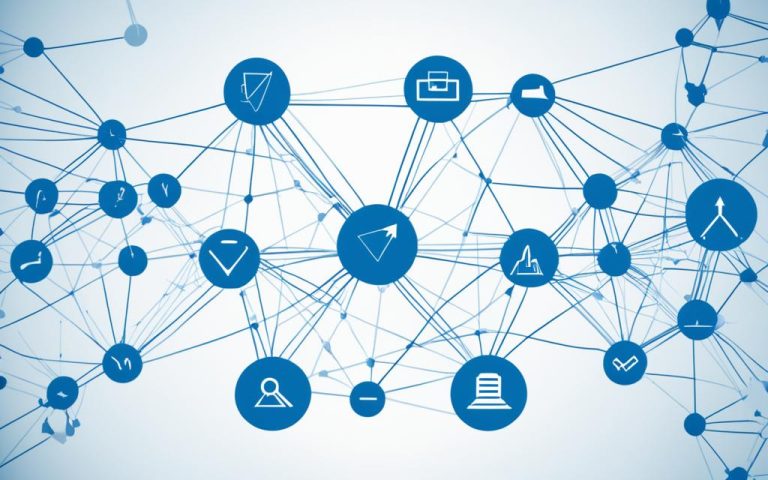A network application is a type of software that uses network resources. It helps devices on a network talk to each other. This makes sharing data and working together easier.
Examples of these apps are web browsers, email clients, and messaging apps. They use computer networks to make work and communication smoother. This helps people and businesses work better together.
Key Takeaways:
- A network application is a software program or service that utilizes network resources to enable communication, data sharing, and collaboration1.
- Examples of network applications include web browsers, email clients, file transfer protocols, messaging apps, video conferencing tools, and remote desktop applications1.
- Network applications leverage the power of computer networks to enhance productivity, facilitate seamless communication, and enable efficient collaboration1.
Types of Network Applications
Network applications are key for communication, sharing data, and many other tasks in computer networks. There are many types, each with its own purpose and needs.
Web browsers let users check out websites, search for info, and interact with online stuff. They use HTTP and HTTPS to talk to web servers and get web pages, images, and videos.
Email clients help send and get emails. They use SMTP, POP3, and IMAP to send, get, and store emails.
File transfer protocols (FTPs) make it safe and easy to send files between devices. Popular FTP apps include FileZilla, WinSCP, and Cyberduck.
Messaging apps let people chat in real-time with instant messages, voice, and video calls. They use XMPP, SIP, and RTP for communication.
Video conferencing tools let people talk face-to-face from anywhere. They use SIP and H.323 for audio and video connections.
Remote desktop applications let you control a computer from afar. They use VNC or RDP to send screen updates and control the keyboard and mouse.
These are just a few examples of network applications. Each one uses special protocols and tech to work well and provide its services.
Reference:2
| Type of Network Application | Functionality | Protocols |
|---|---|---|
| Web browsers | Accessing websites, retrieving web content | HTTP, HTTPS |
| Email clients | Sending and receiving email messages | SMTP, POP3, IMAP |
| File transfer protocols (FTPs) | Secure and efficient file transfer | FTP, SFTP, FTPS |
| Messaging apps | Real-time messaging and voice/video calls | XMPP, SIP, RTP |
| Video conferencing tools | Remote face-to-face discussions | SIP, H.323 |
| Remote desktop applications | Accessing and controlling remote devices | VNC, RDP |
Benefits of Network Applications
Network applications have changed the way we connect and communicate. They make it easier for people and groups to work together. These tools have changed many areas like business, healthcare, education, and entertainment. They make things more efficient, productive, and easy to access.
1. Remote Working and Flexibility
Thanks to networking tech, more people can work from anywhere. This has been especially true during the COVID-19 pandemic. It lets employees stay productive and balance work and life better3.
2. Global Reach in E-commerce
Computer networks have helped e-commerce grow fast. They let businesses reach customers all over the world. Now, companies can sell products or services online, opening up new markets and making more money3.
3. Telemedicine and Remote Medical Consultations
Telemedicine has changed healthcare thanks to networking tech. It lets doctors and patients talk to each other from far away. This cuts down on doctor visits and lowers healthcare costs. It also helps people in remote areas get medical care easier3.
4. Real-time Collaboration and Connectivity
Network apps make it easy for people to work together, no matter where they are. With tools like video calls, instant messaging, and sharing files, teams can work on projects together. This has changed how many industries work, making things more efficient3.
5. Resource Sharing and Cost-cutting Measures
Sharing resources on a computer network saves money for companies. Things like printers and servers can be shared, cutting down on waste. Cloud apps also let people use tools and software without buying them, saving money4.
6. Enhanced Data Security and Management
Network apps focus on keeping data safe. They use strong security steps to protect information from hackers and other threats. They also make it easier to manage data, keeping it safe and in one place4.
7. Improved Communication and Collaboration
Network apps make talking and working together better. They offer ways to send messages, share files, and have video meetings. This helps teams work better together, builds stronger relationships, and makes people more productive4.
Network apps have changed how we work, shop, and communicate. They offer many benefits, from working from home to reaching customers worldwide, and making healthcare better.
For more info on the good and bad of computer networking, check out these resources:
- Advantages and Disadvantages of Computer Networking
- Applications of Computer Network
- Uses of Computer Network
Using network apps can open new doors, make things more efficient, and keep us connected in a world that’s more linked than ever.
Advanced Concepts in Network Applications
Understanding advanced concepts in network applications is key to making them work better and safer. We look into network architecture and topology, the OSI model and TCP/IP, network security, data transfer and latency, API and interconnection, network services and IoT, case studies and metrics, and cloud services and AWS. This knowledge helps developers and IT pros make their applications better and more powerful.
The types of network applications are many and each has its own role online. For example, web browsers like Google Chrome, Mozilla Firefox, and Microsoft Edge help us surf the web. Email clients such as Microsoft Outlook, Apple Mail, and Gmail let us send and receive emails. For moving files, FTP and SFTP are often used. Messaging apps like WhatsApp, Slack, and Microsoft Teams let us talk in real-time. Video conferencing tools like Zoom, Microsoft Teams, and Cisco Webex help us meet online. And remote desktop apps like TeamViewer, AnyDesk, and Remote Desktop Protocol let us access our computers from anywhere.
Network applications bring many benefits to both people and companies. They make it easier to communicate and share data. They make sharing and accessing data better, helping teams work together smoothly. These apps make work easier by automating tasks, saving time. They also help teams work together better, no matter where they are. Plus, they let companies grow and adapt easily.
In the world of advanced concepts, several areas stand out. Network architecture and topology focus on making networks efficient. The OSI model and TCP/IP help networks talk to each other easily. Network security keeps networks and data safe from hackers. Understanding how data moves helps make it faster and more reliable. API and interconnection let apps work together better. Network services and IoT use networks to make things more connected. Case studies and metrics give us insights into how these apps work in real life. And cloud services like AWS offer flexible infrastructure for these apps.
Some5 advanced concepts need extra attention in network applications. For instance, networking and distribution apps use the network but aren’t always seen as distributed apps. They can listen to many events in the network to do specific tasks. Using network apps in SDN architecture can make the controller vulnerable to attacks. So, it’s important to secure these apps. Deep Learning is also used in network management and security, giving us better insights and protection.
The early Internet used a manual HOSTS.TXT table for naming, but as more hosts joined, the Domain Name System (DNS) was created in the mid-1980s. The DNS now has over 1200 top-level domains, like .edu and .com, managed by name servers for safety. Each DNS zone has its own name servers and resource records for redundancy and efficiency.
Key Areas for Advanced Concepts in Network Applications
| Key Area | Description |
|---|---|
| Network Architecture and Topology | Designing and optimizing network structures for efficient data flow. |
| OSI Model and TCP/IP | Framework for network communication and interoperability. |
| Network Security | Ensuring the protection of networks and data from threats. |
| Data Transfer and Latency | Optimizing data transmission for speed and reliability. |
| API and Interconnection | Enabling communication and integration between applications. |
| Network Services and IoT | Leveraging network capabilities to enhance functionality and connectivity. |
| Case Studies and Metrics | Real-world implementations and performance analysis. |
| Cloud Services and AWS | Scalable infrastructure and resources for network applications. |
Network Applications for Startups
Startups today heavily rely on network applications to drive their success. These applications offer numerous benefits, including enhanced connectivity, streamlined workflows, improved communication, and scalability. Network applications empower startups to navigate the digital landscape with agility, efficiency, and the ability to stay ahead of the competition. Let’s explore how startups can leverage the power of network applications to thrive in their industries.
Superior Network Performance for Real-Time Applications
Building real-time applications is a key focus for many tech startups. These applications require superior network performance to prevent latency and jitter issues that can impact user experience. According to statistical data6, tech startups emphasize the need for reliable and fast network performance to support real-time functionalities. To address this need, companies like Subspace provide a proprietary global network engineered specifically for real-time applications. With strategically placed hardware and AI-driven routing, Subspace ensures fast and efficient data transmission, reducing delays and enhancing the overall user experience. This accelerates development processes and enables startups to quickly integrate their applications within hours through a simple API, minimizing the need for extensive training6.
Cost Efficiency through Outsourced Network Performance
One significant advantage network applications offer to startups is the opportunity to outsource network performance, saving on in-house engineering costs. By partnering with companies like Subspace, startups can reduce or eliminate the need for dedicated network engineering teams. This significantly cuts down on operational expenses, allowing startups to allocate resources to other critical areas of their business. Outsourcing network performance also provides startups with access to advanced security features that protect against DDoS attacks and ensure a secure foundation for their applications. Subspace’s network security features detect and remove malicious packets, safeguarding startups’ data and ensuring uninterrupted operations6.
Unleashing Networking Opportunities for Startup Growth
Networking plays a vital role in the growth and success of startups. Establishing connections with industry professionals, potential investors, and like-minded entrepreneurs opens up doors for collaboration, mentorship, and valuable business partnerships. Online platforms such as LinkedIn, CoFoundersLab, and Shapr are invaluable resources in this regard. For instance, according to statistical data7, LinkedIn boasts 310 million monthly active users, offering a robust platform for startups to connect with professionals from various industries. Furthermore, CoFoundersLab provides access to information on thousands of investors and VC firms, while Shapr offers networking opportunities specifically tailored to entrepreneurs7.
Insights and Tailored Development for Success
Before diving into app development, startups need to understand their target audience and their pain points. Conducting surveys and user interviews helps uncover insights necessary for tailored networking app development. Survey data can reveal the need for a more streamlined way to network on the go, given time constraints faced by busy professionals8. User interviews provide valuable information about users’ challenges, goals, and wishlist for an app, influencing app development and ensuring it aligns with user needs. Additionally, third-party market research sheds light on target markets, with young professionals showing a preference for digital connections over in-person networking8.
Successful networking apps focus on a niche, offer a superior user experience, and continuously improve by incorporating user feedback. Statistical data8 suggests that understanding users’ pain points, motivations, preferred platforms, objections, and concerns is key to developing an app experience tailored to their needs. Additionally, building a minimum viable product (MVP) is crucial for validating an app idea. By identifying core features and choosing the right development platform, startups can efficiently test their concept and gather valuable insights to drive success8.
In summary, network applications are indispensable for startups, providing crucial connectivity, scalability, and competitive advantages. By harnessing the power of network applications, startups can boost productivity, cost efficiency, and networking opportunities, enabling accelerated growth and success in the digital era.
Importance of Network Automation
Network automation is key in today’s digital world. It brings many benefits to businesses and IT teams. By using efficient automation, companies can make their networks better, save money, and work more efficiently. Let’s see why network automation is so important and how it can change your business.
Efficiency and Agility
Network automation saves time and money by making processes smoother and more flexible. Automation tools make tasks like setting up networks, testing, and mapping easy9. This leads to networks that work well without a hitch910. Automation also cuts down on mistakes, making networks more reliable9.
Cost Optimization
Using network automation can save businesses a lot of money. It makes software more efficient and cuts out unnecessary costs9. Automation also gives better data for planning, helping save more money9.
Enhanced Performance and Productivity
Automation lets IT teams focus on big projects that help the business grow. It makes delivering services faster and improves network performance10. Standardizing processes makes things easier for everyone and helps with quick network changes10. Automation makes changing networks faster, which used to take a lot of time and effort10.
Reliable Network Infrastructure
Automation with an infrastructure-as-code approach keeps networks stable and well-maintained across different locations10. Automation tools help IT teams manage network settings, track changes, and upgrade remotely easily11. This control makes the network more reliable and stable.
Improved Security and Compliance
Automation is key for better security and following rules in a company. It reduces mistakes and makes network settings more secure11. Automation tools help find vulnerabilities, track user actions, and keep an eye on network access, making the network safe11. Following industry standards is important with automation, helping protect against threats and risks11.
Network automation is vital for businesses wanting to stay ahead and efficient in the fast-changing digital world. By using automation best practices, like analyzing networks, picking the right tools, training teams, focusing on security, and always improving, companies can make their networks better, save money, and reach their full potential.
| Network Automation Benefits | Statistical Data Reference |
|---|---|
| Efficiency and Agility | 9 |
| Cost Optimization | 9 |
| Enhanced Performance and Productivity | 10 |
| Reliable Network Infrastructure | 10 |
| Improved Security and Compliance | 11 |
Creating an Application Network
An application network is key in today’s digital world. It connects applications, data, and devices smoothly. By using APIs and reusable assets, companies can build a strong network. This network boosts innovation, speed, and productivity.
Developing Reusable Assets
Building an application network starts with reusable assets. Things like APIs, connectors, and microservices hold certain functions. They can be used by many apps in the network. This way, companies save time and money, keep things consistent, and work better.
Promoting Self-Service and Reuse
To encourage innovation and teamwork, it’s important to support self-service and reuse. Developers should be able to find and use existing assets easily. Having a central spot for these assets helps teams work together better.
Governance and Security Measures
Even with self-service, companies need strong rules for managing assets. These rules keep data safe and follow the law. They also help keep things consistent and reduce risks. Plus, using secure ways to check who can access data keeps information safe.
Configuration Rules and Network Optimization
Setting up network apps has many important steps. Each app can have up to 8 network rules12. These rules need unique IP addresses, names, or ports to avoid confusion12. The system puts rules in order by how specific they are, so IP addresses and ports come first12. Rules can be IP addresses, names, ports, or a mix12. It’s crucial to set these up right for the best performance.
Application Connectivity Troubleshooting
For the network to work well, it’s key to understand how connections work. The rules for apps are easy to see in the dashboard and Network view12. The troubleshooting guide helps find and fix problems fast12.
Image related to creating an application network:
The Cultural Shift of an Application Network
Creating an application network means a big change in how the company works. It moves IT from making things to helping other parts of the business use those things. This change needs teamwork, letting people help themselves, and following best practices to make new products and ideas.
Old ways of checking company culture focus on what everyone has in common13. Surveys are often used to see what employees value and think about. But, mixing survey info with network analysis shows where people have different values13. Leaders must find these differences to push for new cultural changes13.
About 10% of 400 network engineers use automation right now14. Just 10 engineers know how to make and keep automation systems running14. The move from manual to automated network setup is happening fast to handle big networks14. Packet-based voice and video have done much better than expected, proving they work well14.
Automation will make it faster to make changes and deploy new things14. The goal is to have IT run itself and make applying changes easy14. To start using automation, start with simple automated tasks and then move to more complex ones14.
There are over 1,900 people in the company15. Three cultural traits are key for most of the network15. In one area, connections dropped by 22% when people worked remotely15. Most of this drop was between teams in that area15. But, the main behaviors stayed connected whether people worked together or apart15.
Switching to hybrid work changed how teams connected15. Teams focused on relationships pulled away from those focused on speed15. This could lead to cultural issues if not managed well15. Knowing these changes is key to handling culture in an application network15.
Application Network and IT Capacity Gap
An application network is key in solving the IT capacity gap. It gives companies the tools they need to make their IT infrastructure better and deliver applications well16.
Gigamon is a leader in network visibility, known as the deep observability market17. They are the top company in this field, as shown in the latest 650 Group Deep Observability report17.
Gigamon Application Intelligence helps identify about 4,000 applications right away. It lets companies add their own apps to a special list17. This tool helps companies understand their application traffic better, giving them important data on application performance17.
With Gigamon Application Intelligence, companies can set up rules and filters. These can be simple or complex, based on the company’s needs17. This makes it easier for companies to customize their application networks for their business needs17.
Gigamon Application Intelligence also boosts GigaSMART® solutions. It makes traffic intelligence work better at both the application and network levels17. This closes the gap in application visibility, giving a full view of all applications, their traffic, and details about them17.
ExtraHop’s Application Delivery Assurance System is another big player. It started in 2008 as a top-level application delivery setup18. This system makes it easy to set up and manage new applications, thanks to its automation features18.
The IT capacity gap comes from businesses needing more and technology changing fast16. Companies now handle complex tech like cloud, SaaS apps, IoT, and big data16.
To deal with this gap, companies use different methods. Some focus on making the network work better, while others focus on making applications run smoothly18.
Handling big networks is hard, but ExtraHop’s focus on layer 7 analysis helps find problems missed by others18.
Understanding how different tech parts work together is key for good networked application delivery18.
For companies that need fast, reliable network applications, ExtraHop’s system is a great choice. It helps manage complex infrastructures, ensuring apps work well and users have a good experience18.
Using an application network with tools like Gigamon and ExtraHop helps companies overcome the IT capacity gap. It makes application delivery smoother and boosts IT efficiency17.
| Application Network Solutions | Key Features |
|---|---|
| Gigamon Application Intelligence | – Ability to identify thousands of applications – Enhanced traffic intelligence functions – Rules and filters for tailored application network – Enriched metrics and insights |
| ExtraHop’s Application Delivery Assurance System | – Ease of deployment and automation features – Layer 7 analysis and real-time network monitoring – Optimized performance for network-delivered applications – Scalability for high-capacity network links |
An application network with these solutions lets companies use their IT fully. It helps reduce the IT capacity gap, making apps faster, more reliable, and scalable17.
The Necessity of an Application Network
In today’s fast-changing business world, companies must adapt and innovate quickly. With rising customer expectations and new tech, an application network is key. It helps businesses stay ahead, offering the agility needed to meet new market trends and bring fresh solutions.
For the past 2 to 3 years, IT investment has been steady, but it’s not enough to keep up with growing demands from the business19. Yet, it’s crucial to keep IT projects efficient and on track. Many CIOs worry about falling behind and expect more projects soon19.
The old way of managing IT is causing delays and missed goals19. To fix this, companies are turning to application networks. These networks help improve IT delivery and integration20. They bring discipline in using, sharing, and reusing resources, leading to better teamwork and building communities around certain skills19.
Application networks bring many benefits, like better control over assets, improved performance, and quick delivery of new products and services19. They use APIs to connect applications, data, and devices smoothly, creating value units that can be easily managed and added to the network20.
They also make integration easier by using reusable templates, cutting down on manual coding, and simplifying complex connections20. This shift in IT helps different groups access and use data safely and fast, speeding up projects and creating reusable assets20.
Starting with an application network brings long-term benefits, giving companies the agility to handle digital changes19. As demands for innovation and excellence grow, an application network is key to staying competitive and delivering new solutions and experiences20.
In conclusion, an application network is vital for today’s fast-paced businesses. It helps bridge the IT gap, boosts security and integration, and encourages innovation and agility for success19.
Benefits of an Application Network
Building an application network brings many advantages. It makes things faster, saves time, and helps teams work better together. It also makes sure projects are done well and keeps data safe.
An application network makes things increased agility by linking apps and systems together. This means data moves smoothly and works well with others. It helps companies quickly adjust to new market trends and what customers want, keeping them ahead in fast-changing fields21.
With an application network, companies can reuse assets like APIs and connectors. This means they don’t have to start over on each project. It saves time and money and makes sure things are done the same way every time22.
Another big plus is efficient project delivery. Using the same parts and patterns makes making projects faster. This cuts down on time spent on projects, makes customers happier, and lets companies grab new chances quickly22.
An application network also helps with improved collaboration. It gets rid of walls between teams, making it easier for them to work together. With data easy to get, teams can make decisions fast, work better together, and come up with new ideas23.
One of the main perks is governance and security. It makes sure who can see what, keeps an eye on things, and follows rules. This keeps data safe, follows laws, and fights off cyber threats. It builds trust with customers and others23.
In short, an application network has lots of big benefits. It makes things faster, saves time, and helps teams work better. It also makes sure projects are done well and keeps data safe. Companies can use it to be more innovative, adapt to changes, and grow in a lasting way.
Conclusion
Network applications are key to how we communicate, share data, and work together. They’ve changed many industries and sectors. The 1990s saw a big shift with more knowledge, money, tech, and skilled workers available worldwide24. This helped boost economic growth and innovation.
But, while tech has grown a lot in some areas, research on networks in the mind and social spaces is still catching up24. There’s a big gap between how important networks are and the support they get for research24. Network science could really help solve big social issues and improve how we work together24.
The Internet supports many areas like health care, education, and research25. Yet, it doesn’t fully meet the needs of these fields in terms of security and quality25. Keeping information safe on the Internet is crucial, especially in health care25. As new apps are developed, they must keep up with the tech needed for these fields25.
Creating things like the SSN Ontology helps networks work better together26. Using the SSN Ontology can make sharing data easier26. But, making sure these ontologies fit together well is hard and needs more work26. To help with this, setting up a group at W3C to work on the SSN Ontology is a good idea26.
FAQ
What is a network application?
A network application is a software program that uses network resources. It helps devices on a network communicate, share data, and work together.
What are some examples of network applications?
Examples include web browsers, email clients, and file transfer protocols. Other examples are messaging apps, video conferencing tools, and remote desktop applications.
What are the types of network applications?
Common types are web browsers, email clients, and file transfer protocols. There are also messaging apps, video conferencing tools, and remote desktop applications.
What are the benefits of network applications?
They improve connectivity and make communication and collaboration easier. They also make data sharing and access easier. Plus, they streamline workflows, support remote work, and help with growth.
What advanced concepts are important in network applications?
Important concepts include network architecture and the OSI model. Also, TCP/IP, network security, and data transfer are key. API and IoT, case studies, and cloud services like AWS are also crucial.
How can network applications benefit startups?
They offer many benefits for startups. These include better connectivity and workflow efficiency. They also improve communication and support scalability and fast demos.
Why is network automation important?
It’s key for managing network traffic and optimizing performance. It helps troubleshoot issues and supports scalability and adaptability to business needs.
What is an application network?
It connects applications, data, and devices through APIs. This allows for the discovery and reuse of assets and better collaboration within an organization.
How do you create an application network?
You build it by developing reusable assets and encouraging self-service. It also involves setting up governance and security measures.
What is the cultural shift needed for an application network?
A cultural shift is needed, changing how IT works. It moves from being a producer to an enabler for the business. It also requires collaboration and adopting best practices for innovation.
How can an application network help bridge the IT capacity gap?
It helps by enabling asset reuse and empowering teams to self-serve and collaborate. This leads to faster project completion and less reliance on experts. It also supports centralized management and security.
Why is an application network necessary in a rapidly changing business environment?
It’s needed to thrive in a fast-changing business world. It brings agility and flexibility for adapting and innovating. This helps in delivering new products efficiently and securing assets.
What are the benefits of building an application network?
Building one brings many benefits. These include increased agility and reusability of assets. It also leads to efficient project delivery, better collaboration, and improved security. Plus, it supports innovation and helps in adapting to change.
Source Links
- https://www.techtarget.com/searchnetworking/definition/network – What is a Computer Network? | Definition from TechTarget
- https://www.spiceworks.com/tech/networking/articles/what-is-network-software/ – What Is Network Software? Definition, Types, Components, and Best Practices – Spiceworks
- https://www.geeksforgeeks.org/advantages-and-disadvantages-of-computer-networking/ – Advantages and Disadvantages of Computer Networking – GeeksforGeeks
- https://www.geeksforgeeks.org/uses-of-computer-network/ – Uses of Computer Network – GeeksforGeeks
- https://www.sciencedirect.com/topics/computer-science/network-application – Network Application – an overview
- https://subspace.com/business/startups – Network Service for Startups
- https://startupsavant.com/service-reviews/best-networking-platforms-for-startups – Startup Networking – Best Networking Platforms for Startups
- https://aleph1.io/blog/launch-your-networking-app-guide/ – A Step-by-Step Guide to Launching Your Networking App | Aleph One
- https://www.cprime.com/resources/blog/what-are-the-benefits-of-network-automation/ – What Are the Benefits of Network Automation?
- https://blogs.vmware.com/networkvirtualization/2020/06/7-reasons-why-network-automation.html/ – Seven Reasons Why Network Automation Is Important
- https://www.manageengine.com/network-configuration-manager/importance-of-network-automation.html – Network Configuration Management by ManageEngine Network Configuration Manager
- https://docs.nexthink.com/platform/user-guide/applications/managing-applications/configuring-network-applications – Configuring network applications | Nexthink Documentation
- https://sloanreview.mit.edu/article/use-networks-to-drive-culture-change/ – Use Networks to Drive Culture Change
- https://www.nojitter.com/enterprise-networking/embracing-culture-change-network-automation – Embracing The Culture Change of Network Automation
- https://www.hrdconnect.com/2023/04/28/culture-clusters-a-new-network-approach-for-driving-culture-change/ – Culture clusters: A new network approach for driving culture change – HRD
- https://gyansys.com/it-delivery-gap/ – IT Delivery Gap: How To Reduce It?
- https://blog.gigamon.com/2023/06/20/do-you-have-an-application-visibility-gap/ – Do You Have an Application Visibility Gap? – Gigamon Blog
- https://assets.extrahop.com/uploads/resources/downloads/analyst-reports/ema-extrahop-launch-ib.pdf – PDF
- https://www.mulesoft.com/resources/api/what-is-an-application-network – What is an application network? | MuleSoft
- https://www.mulesoft.com/resources/api/application-network-integration-middleware – Application networks are the next generation of integration middleware | MuleSoft
- https://www.michaelpage.com.au/advice/career-advice/career-progression/top-12-benefits-networking-why-networking-important – Top 12 benefits of networking: Why networking is important | Michael Page
- https://techtarget.com/searchsoftwarequality/definition/Web-application-Web-app – What is Web Application (Web Apps) and its Benefits
- https://www.extnoc.com/learn/networking/top-benefits-of-network-monitoring – What are the Top Benefits of Network Monitoring? – ExterNetworks
- https://nap.nationalacademies.org/read/11516/chapter/10 – 8 Conclusions and Recommendations | Network Science
- https://www.ncbi.nlm.nih.gov/sites/books/NBK44720/ – Conclusions and Recommendations – Networking Health
- https://www.w3.org/2005/Incubator/ssn/wiki/Report_Conclusion_and_Recommendations.html – Report Conclusion and Recommendations – Semantic Sensor Network Incubator Group



















